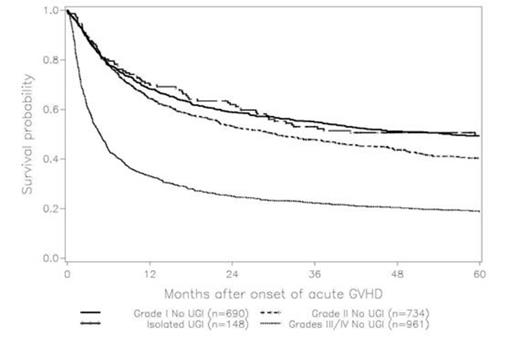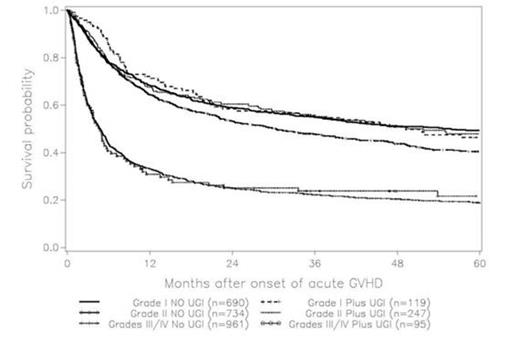Abstract
The clinical syndrome of acute upper gastrointestinal graft-versus-host disease (UGI aGvHD) is historically seen in 13% of MRD transplants and in 31% of recipients developing acute GvHD (aGvHD). UGI aGvHD is classified as a Grade II manifestation in the modified consensus criteria and often treated with systemic immunosuppressive therapy. We undertook a review of the CIBMTR database to assess prognostic implications of and outcomes after UGI aGvHD both in isolation and when present with other manifestations of aGvHD.
Methods: 8567 adult recipients of myeloablative allogeneic HSCTs receiving T-cell replete PBSC or bone marrow grafts from siblings, well- or partially-matched unrelated donors for AML, ALL, CML or MDS between 2000 and 2012 were analyzed. The primary outcome was survival; secondary outcomes were DFS, TRM, relapse, and cGvHD. Isolated UGI aGvHD: we performed individual pairwise comparisons between recipients with isolated UGI (iUGI) aGvHD and those with no aGvHD, Grade I, Grade II or Grades III/IV aGvHD without UGI symptoms. UGI aGvHD in Addition to Other aGvHD Manifestations: we performed pairwise comparisons between recipients with aGvHD of the same grade, with and without UGI involvement. Recipients with Grade II aGvHD were reclassified for analysis based on non-UGI manifestations. Diagnoses of UGI aGvHD did not require biopsy confirmation. Analyzed covariates included age, race, KPS score, malignancy, disease stage, time from diagnosis to transplant, graft source, HLA-matching, sex match, CMV status, GvHD prophylaxis, and year of transplant. Analyses were adjusted for effect of transplant center on outcomes. Given the number of comparisons, a p value <0.01 determined significance. Recipients without aGvHD included those experiencing early death; Kaplan-Meier and incidence curves were analyzed from time of aGvHD onset.
Results: 251 centers contributed. Median age of recipients was 42 years (range, 18-72). 49% of recipients received stem cells from HLA-matched siblings, 38% from well-matched and 13% from partially-matched unrelated donors. 20% of donor/recipient pairs were female->male. 71% received PBSCs. Isolated UGI aGvHD: 229 individuals had iUGI aGvHD. MRD recipients with iUGI aGvHD had the same prognoses for OS, DFS, TRM, relapse and chronic GvHD as recipients with Grades 0, I or II aGvHD without UGI symptoms in pairwise comparisons. URD recipients with iUGI aGvHD had decreased TRM and trended towards improved OS and DFS compared to recipients with Grade II aGvHD without UGI involvement (HR 2.70, p=0.0021; HR 1.59, p=0.0166; HR 1.52, p=0.0294; Table, Figure 1). Outcomes of URD recipients with iUGI aGvHD were similar to those with Grades 0 or I aGvHD in pairwise comparisons. UGI aGvHD in Addition to Other aGvHD Manifestations: UGI involvement added no significant prognostic information to analyzed outcomes when present in addition to Grades I or II aGvHD of skin or hepatic/lower GI origin (Figure 2). If UGI symptoms were removed from grading, 229 recipients would be reclassified as No aGvHD; 196 recipients would be reclassified as Grade I. The percentage of recipients with Grades 0/I GvHD would increase from 55.7% to 60.1%.
Conclusions: The presence of isolated UGI aGvHD imparted limited prognostic information after MRD or URD transplantation in terms of OS, DFS, TRM, relapse or chronic GvHD when compared to recipients without aGvHD or those with Grade I or II manifestations other than UGI. Defining isolated UGI aGvHD as a Grade II entity is not supported by this analysis. The presence of UGI aGvHD in addition to other Grade I or Grade II manifestations within a given recipient likewise had minimal prognostic impact on clinical outcomes after MRD or URD HSCT. Inclusion of UGI symptoms in the current aGvHD grading schema warrants re-evaluation in light of the results of this analysis.
Overall Survival - Isolated UGI aGvHD versus grades of aGvHD without UGI involvement
Overall Survival - Isolated UGI aGvHD versus grades of aGvHD without UGI involvement
Survival for URD recipients with isolated UGI versus grades of aGvHD without UGI involvement
Survival for URD recipients with isolated UGI versus grades of aGvHD without UGI involvement
Survival for URD recipients with aGvHD manifestations in addition to or without UGI symptoms
Survival for URD recipients with aGvHD manifestations in addition to or without UGI symptoms
Alousi:Therakos, Inc: Research Funding.
Author notes
Asterisk with author names denotes non-ASH members.




This feature is available to Subscribers Only
Sign In or Create an Account Close Modal